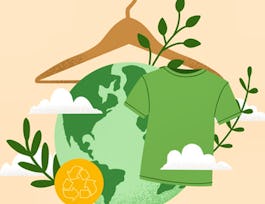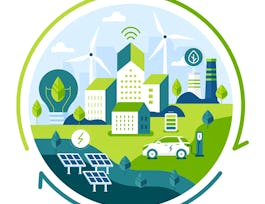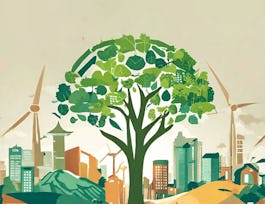The Circular Economy is about zero waste, where products are disassembled into their constituent components, either to be recycled or composted. While considerable attention has focused on the product itself, a product can only be sustainable or circular if the packaging it comes in is also sustainable and circular. This second course in the “Sustainable and Circular Product Development” specialization provides an overview of packaging today, and how it is evolving to become more sustainable. Topics include defining sustainable and circular packaging, packaging as a system, design and functionality, conventional and innovative packaging materials, advances in recycling technologies, and rethinking our approach to packaging.



Packaging Design for the Circular Economy

Instructor: Michael J. Readey, Ph.D.
Top Instructor
Sponsored by ITC-Infotech
Recommended experience
What you'll learn
Make informed purchasing decisions by identifying sustainable and circular attributes of packaging.
Explain the importance and function of packaging.
Describe how packaging is designed and tested.
Explain different packaging materials, from paper to plastic, and the innovative technologies on the horizon.
Details to know

Add to your LinkedIn profile
19 assignments
December 2024
See how employees at top companies are mastering in-demand skills


Earn a career certificate
Add this credential to your LinkedIn profile, resume, or CV
Share it on social media and in your performance review

There are 5 modules in this course
The module begins with an overview of packaging fundamentals, such as what packaging is and why we need it. We then discuss the challenges with packaging, from the amount of packaging that ends up in the landfill to the particular challenges with plastic packaging. The module explains the many functions of packaging, from protection and preservation to communication and sustainability. Finally, the module examines packaging as a system, including primary, secondary and tertiary packaging, as well as how labels play an important role in communication and logistics.
What's included
9 videos6 readings4 assignments1 discussion prompt
Economic growth around the world will lead to greater consumption of stuff, and all that stuff will come packaged in one form or another. In this module, we discuss the 3 pillars of sustainability: People-Planet-Profits, otherwise known as the Triple Bottom Line, and how it relates to packaging. We introduce the concept of the Circular Economy, and its primary tenet that nothing is considered waste - including packaging. We then explore current consumer trends that prefer sustainable and circular packaging, and our collective dislike of plastic packaging. And industry is responding, with innovative approaches to both design and materials. We wrap-up this module examining how we can get from where we are today, to where we need to be tomorrow, highlighting the different approaches to making our packaging more sustainable and circular.
What's included
8 videos2 readings4 assignments
The principles of the Circular Economy apply to packaging as much as they do to product design. In this module, we discuss packaging design from a packaging engineer's perspective, and the many elements they must consider to ensure the packaging meets business, customer and regulatory requirements. We then go deeper into those elements, including protection, material use, and user-friendliness, to name a few. To understand how these work in practice, several examples are highlighted from companies such as Ikea, Amazon and Puma. Finally, we examine the tools packaging professionals use to design packaging, such as CAD, VR and AR, and the tests used to validate packaging, such as crush tests, drop tests, and atmospheric conditioning. This module lays the groundwork for more sustainable circular packaging design, covered in the next few modules.
What's included
8 videos5 readings5 assignments
Packaging design relies heavily on material properties to protect the product from structural damage, light and UV damage, as well as intrusion (or leakage) of gases such as oxygen or ethylene. Packaging materials have come a long way, but not necessarily with sustainability in mind. In this module, we explore the mix of packaging materials today, including paper, paperboard and cardboard, glass, aluminum and plastics. We go into each in some detail, highlighting what they are, how they are made, and where the materials are heading in terms of sustainability and circularity.
What's included
9 videos5 readings4 assignments
Many businesses and consumers are now fully aware of the adverse environmental impacts of packaging. Yet as we often try to do in this course, those challenges create the opportunities for change. In this module, we highlight the innovations occurring in packaging materials, how reuse is possible, and conclude with examples of creative entrepreneurs rethinking packaging altogether. The module begins with advances in biopolymers and bioplastics, highlighting the many exciting advances in the field. There are also several earth-friendly packaging materials on the horizon, including those made from mushrooms and seaweed. Innovation goes beyond materials to business models, where true circularity is achieved by reusing packaging, led by a company that designed robust packaging envelopes suitable for reuse, but also the reverse logistics process to ensure they are reused. The module then introduces several designers reexamining the relationship between product and packaging, and ultimately making both more sustainable. Finally the course wraps up with an optimistic view of the potential for more sustainable and circular packaging, the people and organizations leading the way, and what we can do to accelerate the transition.
What's included
6 videos5 readings2 assignments
Instructor

Offered by
Why people choose Coursera for their career




Recommended if you're interested in Physical Science and Engineering

University of Colorado Boulder

University of Colorado Boulder

University of Colorado Boulder

University of Colorado Boulder

Open new doors with Coursera Plus
Unlimited access to 10,000+ world-class courses, hands-on projects, and job-ready certificate programs - all included in your subscription
Advance your career with an online degree
Earn a degree from world-class universities - 100% online
Join over 3,400 global companies that choose Coursera for Business
Upskill your employees to excel in the digital economy


